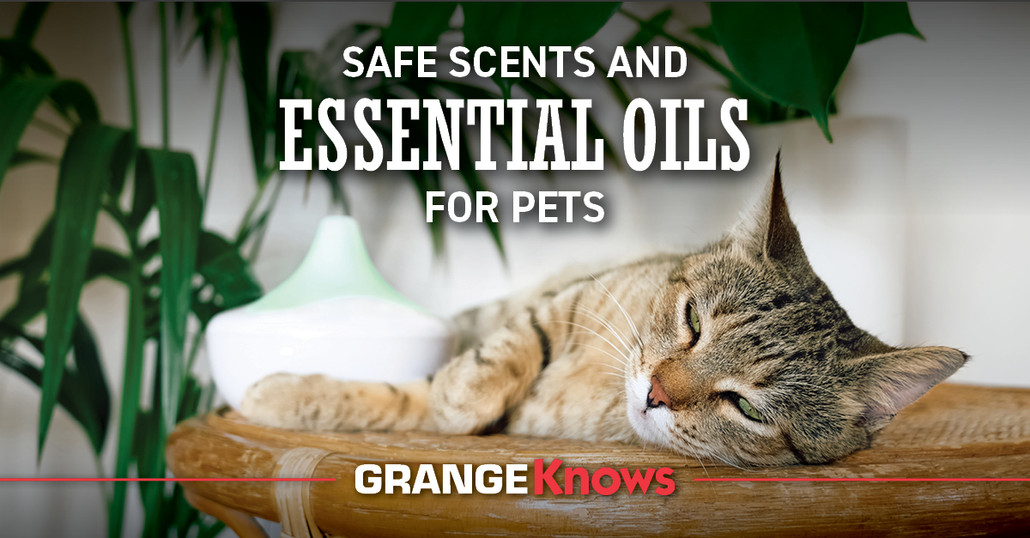
Safe Scents and Essential Oils for Pets
Posted by Grange Co-op on 18th Feb 2025
Essential oils have become popular for their soothing, aromatic properties and versatile uses in homes, but if you’re a pet owner, you may wonder whether these fragrant substances are safe for your furry companions. Pets, especially cats, dogs, and birds, have sensitive respiratory systems and metabolisms that can react differently to essential oils compared to humans. While some oils can provide benefits, others may pose serious risks.
In this blog, we’ll explore the safest essential oils for pets, how to use them responsibly, and the key dos and don’ts to ensure your beloved animals stay happy and healthy.
Why Essential Oils Can Be Dangerous for Pets
Essential oils are highly concentrated plant extracts. While they may seem natural and harmless, their potency means they can overwhelm a pet’s senses or even cause toxicity when used improperly.
- Respiratory Sensitivity: Pets have a more acute sense of smell, which can make strong aromas overwhelming or irritating.
- Toxic Ingestion: Some pets may lick oils that are applied to their fur, leading to digestive upset or poisoning.
- Metabolic Differences: Cats, for instance, lack certain liver enzymes needed to process compounds in essential oils, making them especially vulnerable.
Always consult with your veterinarian before introducing essential oils into your pet’s environment.
Safe Essential Oils for Pets
When used carefully and in moderation, certain essential oils can be beneficial for pets. Here are some of the safest options:
- Lavender
- Benefits: Known for its calming properties, lavender can help reduce anxiety in dogs and cats during stressful events like thunderstorms or car rides.
- Use: Diffuse in small amounts or dilute before applying topically.
- Chamomile
- Benefits: Chamomile’s gentle, soothing aroma is great for relaxation and can also help with minor skin irritations.
- Use: Add a few drops to a diffuser or dilute and apply to a pet-safe balm for irritated skin.
- Frankincense
- Benefits: Frankincense supports the immune system and can promote relaxation without being overwhelming.
- Use: Safe for diffusion or diluted topical use on dogs.
- Cedarwood
- Benefits: Cedarwood is often used as a natural insect repellent and can help calm pets.
- Use: Dilute well before use and avoid prolonged exposure.
- Ginger
- Benefits: Ginger essential oil can ease nausea or digestive discomfort in dogs.
- Use: Diffuse or use a tiny amount diluted in a carrier oil.
Essential Oils to Avoid for Pets
While some oils are safe, many can be harmful or even toxic. Avoid the following:
- Tea Tree Oil: Toxic to both cats and dogs, even in small amounts.
- Citrus Oils (e.g., Lemon, Orange, Grapefruit): These can irritate a pet’s skin and are especially dangerous for cats.
- Peppermint: Can cause respiratory issues and discomfort.
- Eucalyptus: Toxic to pets when ingested or applied to the skin.
- Clove and Cinnamon Oils: Known to irritate the skin and mucous membranes.
How to Use Essential Oils Safely Around Pets
- Diffuse with Caution
- Only use a diffuser in a well-ventilated area where your pet can leave the room if the aroma is too strong.
- Limit diffusion time to 30 minutes to avoid overexposure.
- Dilute, Dilute, Dilute
- Essential oils should always be diluted with a pet-safe carrier oil (e.g., coconut or olive oil) before topical use. The dilution ratio should be 1 drop of essential oil per 50 drops of carrier oil.
- Never Apply Directly to Fur or Skin
- Unless advised by a vet, avoid applying essential oils directly to your pet’s coat or skin. This minimizes the risk of ingestion or irritation.
- Keep Oils Out of Reach
- Store essential oils in a secure place where curious pets can’t accidentally knock over bottles or ingest them.
- Monitor Your Pet’s Reaction
- If you’re introducing a new oil, watch for signs of discomfort, such as sneezing, drooling, excessive scratching, or lethargy. Stop use immediately if these occur. Remember to always contact your vet if you have any questions or concerns about using essential oils on or around your pet.
Pet-Friendly Uses of Essential Oils
- Calming Anxiety
Diffusing lavender or chamomile oil during stressful situations, such as fireworks or vet visits, can help soothe an anxious pet. - Natural Flea and Tick Repellent
Diluted cedarwood or lemongrass oil can be used sparingly as a natural insect repellent. As a reminder, always consult your vet first. - Odor Neutralizer
A few drops of safe essential oil added to water can freshen up pet bedding or neutralize odors in your home.
Alternatives to Essential Oils
If you’re unsure about using essential oils around your pets, there are safer alternatives for many of their uses:
- Herbal Sprays: Pre-made sprays use diluted plant extracts and are often designed with pet safety in mind.
- Pet-Safe Cleaning Products: Opt for products specifically labeled as non-toxic for pets.
- Aromatherapy Toys: Some toys are infused with pet-friendly scents to help calm anxious animals.
Signs of Essential Oil Toxicity in Pets
If your pet is exposed to harmful oils, they may show the following symptoms:
- Difficulty breathing
- Drooling or vomiting
- Lethargy or uncoordinated movement
- Skin irritation
If you suspect your pet has been poisoned, contact your veterinarian or an animal poison control center immediately.
Conclusion: A Safe and Soothing Environment
When used responsibly, essential oils can enhance your pet’s environment and improve their well-being. Always prioritize your pet’s safety by choosing oils carefully, diluting them appropriately, and monitoring their reactions.
At Grange Co-op, we’re here to help you make informed decisions about the products you use in your home. Stop by your local Grange Co-op for advice on pet-safe products and other natural solutions for your furry friends. Together, we can create a harmonious, healthy space for you and your pets to thrive.
